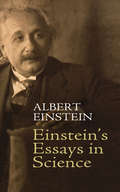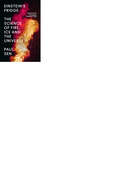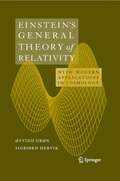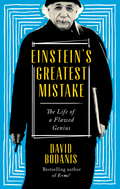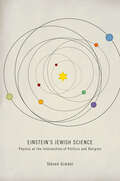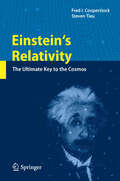- Table View
- List View
Einstein's Enigma or Black Holes in My Bubble Bath
by C.V. VishveshwaraThis is a fascinating and enjoyable popular science book on gravity and black holes. It offers an absorbing account on the history of research on the universe and gravity from Aristotle via Copernicus via Newton to Einstein. The author possesses high literary qualities and is celebrated relativist. The physics of black holes constitutes one of the most fascinating chapters in modern science. At the same time, there is a fanciful quality associated with this strange and beautiful entity. The black hole story is undoubtedly an adventure through physics, philosophy, history, fiction and fantasy. This book is an attempt to blend all these elements together.
Einstein's Entanglement: Bell Inequalities, Relativity, and the Qubit
by Prof W. M. Stuckey Prof Michael Silberstein Dr Timothy McDevittEinstein introduced quantum entanglement in 1935 and referred to it as “spooky actions at a distance” because it seemed to conflict with his theory of special relativity. Today, some refer to it as "the greatest mystery in physics" and the 2022 Nobel Prize in Physics was even awarded for experimental confirmation of the "spookiness." While the mystery is experimentally well-established, its solution remains elusive because it is commonly believed that quantum entanglement entails that quantum mechanics is incomplete, that the world works according to "spooky actions at a distance," that causes from the future create effects in the present, that there is "superdeterministic" causal control of experimental procedures, that people can correctly disagree on the outcome of one and the same experiment, and that a single experimental measurement can produce all possible outcomes. In this book, a rigorous solution to the mystery of quantum entanglement is provided that entails none of those things. The key to this seemingly impossible feat is - to use Einstein's own language - a "principle" explanation that foregoes the need for any "constructive" explanation of quantum entanglement, such as those listed above. Ironically, the proposed principle explanation is Einstein's own relativity principle as grounded in quantum information theory. So contrary to popular belief, quantum mechanics and special relativity are far from inconsistent, as both are a consequence of the exact same relativity principle.
Einstein's Essays in Science
by Albert Einstein Alan HarrisHis name is synonymous with "genius," but these essays by the renowned physicist and scholar are accessible to any reader. In addition to outlining the core of relativity theory in everyday language, Albert Einstein presents fascinating discussions of other scientific fields to which he made significant contributions. The Nobel Laureate also profiles some of history's most influential physicists, upon whose studies his own work was based.Assembled during Einstein's lifetime from his speeches and essays, this book marks the first presentation to the wider world of the scientist's accomplishments in the field of abstract physics. Along with relativity theory, these articles examine the methods of theoretical physics, principles of research, and the concept of scientific truth. Einstein's speeches to audiences at Columbia University and the Prussian Academy of Science appear here, along with his insightful observations on such giants of science as Johannes Kepler, Sir Isaac Newton, James Clerk Maxwell, Niels Bohr, Max Planck, and others.
Einstein’s Field Equations and Their Physical Implications: Selected Essays in Honour of Jürgen Ehlers (Lecture Notes in Physics #540)
by Bernd G. SchmidtThis book serves two purposes. The authors present important aspects of modern research on the mathematical structure of Einstein's field equations and they show how to extract their physical content from them by mathematically exact methods. The essays are devoted to exact solutions and to the Cauchy problem of the field equations as well as to post-Newtonian approximations that have direct physical implications. Further topics concern quantum gravity and optics in gravitational fields.The book addresses researchers in relativity and differential geometry but can also be used as additional reading material for graduate students.
Einstein’s Fridge: The Science Of Fire, Ice And The Universe
by Paul SenA compulsively readable account of the extraordinary people, battling internal demons and external adversaries, who discovered the laws of thermodynamics and the science of heat, and brought about a scientific revolution.
Einstein's General Theory of Relativity: With Modern Applications in Cosmology
by Øyvind Grøn Sigbjorn HervikThis book introduces the general theory of relativity and includes applications to cosmology. The book provides a thorough introduction to tensor calculus and curved manifolds. After the necessary mathematical tools are introduced, the authors offer a thorough presentation of the theory of relativity. Also included are some advanced topics not previously covered by textbooks, including Kaluza-Klein theory, Israel's formalism and branes. Anisotropic cosmological models are also included. The book contains a large number of new exercises and examples, each with separate headings. The reader will benefit from an updated introduction to general relativity including the most recent developments in cosmology.
Einstein's Generation: The Origins of the Relativity Revolution
by Richard StaleyWhy do we celebrate Einstein’s era above all other epochs in the history of physics? Much of the history of physics at the beginning of the twentieth century has been written with a sharp focus on a few key figures and a handful of notable events. Einstein’s Generation offers a distinctive new approach to the origins of modern physics by exploring both the material culture that stimulated relativity and the reaction of Einstein’s colleagues to his pioneering work. Richard Staley weaves together the diverse strands of experimental and theoretical physics, commercial instrument making, and the sociology of physics around 1900 to present the collective efforts of a group whose work helped set the stage for Einstein’s revolutionary theories and the transition from classical to modern physics that followed. Collecting papers, talks, catalogues, conferences, and correspondence, Staley juxtaposes scientists’ views of relativity at the time to modern accounts of its history. Einstein’s Generation tells the story of a group of individuals which produced some of the most significant advances of the twentieth century; and challenges our celebration of Einstein’s era above all others.
Einstein's Greatest Mistake: The Life of a Flawed Genius
by David BodanisWidely considered the greatest genius of all time, Albert Einstein revolutionised our understanding of the cosmos with his general theory of relativity and helped to lead us into the atomic age. Yet in the final decades of his life he was also ignored by most working scientists, his ideas opposed by even his closest friends. This stunning downfall can be traced to Einstein's earliest successes and to personal qualities that were at first his best assets. Einstein's imagination and self-confidence served him well as he sought to reveal the universe's structure, but when it came to newer revelations in the field of quantum mechanics, these same traits undermined his quest for the ultimate truth. David Bodanis traces the arc of Einstein's intellectual development across his professional and personal life, showing how Einstein's confidence in his own powers of intuition proved to be both his greatest strength and his ultimate undoing. He was a fallible genius. An intimate and enlightening biography of the celebrated physicist, Einstein's Greatest Mistake reveals how much we owe Einstein today - and how much more he might have achieved if not for his all-too-human flaws.
Einstein's Jewish Science: Physics at the Intersection of Politics and Religion
by Steven GimbelIs relativity Jewish? The Nazis denigrated Albert Einstein’s revolutionary theory by calling it "Jewish science," a charge typical of the ideological excesses of Hitler and his followers. Philosopher of science Steven Gimbel explores the many meanings of this provocative phrase and considers whether there is any sense in which Einstein’s theory of relativity is Jewish. Arguing that we must take seriously the possibility that the Nazis were in some measure correct, Gimbel examines Einstein and his work to explore how beliefs, background, and environment may—or may not—have influenced the work of the scientist. You cannot understand Einstein’s science, Gimbel declares, without knowing the history, religion, and philosophy that influenced it. No one, especially Einstein himself, denies Einstein's Jewish heritage, but many are uncomfortable saying that he was being a Jew while he was at his desk working. To understand what "Jewish" means for Einstein’s work, Gimbel first explores the many definitions of "Jewish" and asks whether there are elements of Talmudic thinking apparent in Einstein’s theory of relativity. He applies this line of inquiry to other scientists, including Isaac Newton, René Descartes, Sigmund Freud, and Émile Durkheim, to consider whether their specific religious beliefs or backgrounds manifested in their scientific endeavors. Einstein's Jewish Science intertwines science, history, philosophy, theology, and politics in fresh and fascinating ways to solve the multifaceted riddle of what religion means—and what it means to science. There are some senses, Gimbel claims, in which Jews can find a special connection to E = mc2, and this claim leads to the engaging, spirited debate at the heart of this book.
Einstein's Jury: The Race to Test Relativity
by Jeffrey CrelinstenEinstein's Jury is the dramatic story of how astronomers in Germany, England, and America competed to test Einstein's developing theory of relativity. Weaving a rich narrative based on extensive archival research, Jeffrey Crelinsten shows how these early scientific debates shaped cultural attitudes we hold today. The book examines Einstein's theory of general relativity through the eyes of astronomers, many of whom were not convinced of the legitimacy of Einstein's startling breakthrough. These were individuals with international reputations to uphold and benefactors and shareholders to please, yet few of them understood the new theory coming from the pen of Germany's up-and-coming theoretical physicist, Albert Einstein. Some tried to test his theory early in its development but got no results. Others--through toil and hardship, great expense, and perseverance--concluded that it was wrong. A tale of international competition and intrigue, Einstein's Jury brims with detail gleaned from Crelinsten's far-reaching inquiry into the history and development of relativity. Crelinsten concludes that the well-known British eclipse expedition of 1919 that made Einstein famous had less to do with the scientific acceptance of his theory than with his burgeoning public fame. It was not until the 1920s, when the center of gravity of astronomy and physics shifted from Europe to America, that the work of prestigious American observatories legitimized Einstein's work. As Crelinsten so expertly shows, the glow that now surrounds the famous scientist had its beginnings in these early debates among professional scientists working in the glare of the public spotlight.
Einstein's Masterwork: 1915 and the General Theory of Relativity
by John GribbinIn 1915, Albert Einstein unveiled his masterwork – a theory, in his words, ‘of incomparable beauty’: the General Theory of Relativity. It is sometimes overshadowed – wrongly, argues John Gribbin – by his work of 1905, the Special Theory of Relativity and E = mc². Just over 100 years later, the first direct detection of gravitational radiation is seen as the ultimate proof of the General Theory’s accuracy. The General Theory describes the evolution of the Universe, black holes, the behaviour of orbiting neutron stars, and why clocks run slower on Earth than in space. It even suggests the possibility of time travel. In this ‘beautifully written and highly accessible account of the genesis of a great theory’ (Physics World), Gribbin vividly illustrates what an incomparable scientist Albert Einstein really was.
Einstein's Miraculous Year: Five Papers That Changed the Face of Physics
by Albert EinsteinFive extraordinary papers by Albert Einstein that transformed physics, edited and introduced by John Stachel and with a foreword by Nobel laureate Roger Penrose After 1905, Einstein's miraculous year, physics would never be the same again. In those twelve months, Einstein shattered many cherished scientific beliefs with five extraordinary papers that would establish him as the world's leading physicist. This book brings those papers together in an accessible format. The best-known papers are the two that founded special relativity: On the Electrodynamics of Moving Bodies and Does the Inertia of a Body Depend on Its Energy Content? In the former, Einstein showed that absolute time had to be replaced by a new absolute: the speed of light. In the second, he asserted the equivalence of mass and energy, which would lead to the famous formula E = mc2.The book also includes On a Heuristic Point of View Concerning the Production and Transformation of Light, in which Einstein challenged the wave theory of light, suggesting that light could also be regarded as a collection of particles. This helped to open the door to a whole new world—that of quantum physics. For ideas in this paper, he won the Nobel Prize in 1921.The fourth paper also led to a Nobel Prize, although for another scientist, Jean Perrin. On the Movement of Small Particles Suspended in Stationary Liquids Required by the Molecular-Kinetic Theory of Heat concerns the Brownian motion of such particles. With profound insight, Einstein blended ideas from kinetic theory and classical hydrodynamics to derive an equation for the mean free path of such particles as a function of the time, which Perrin confirmed experimentally. The fifth paper, A New Determination of Molecular Dimensions, was Einstein's doctoral dissertation, and remains among his most cited articles. It shows how to calculate Avogadro's number and the size of molecules.These papers, presented in a modern English translation, are essential reading for any physicist, mathematician, or astrophysicist. Far more than just a collection of scientific articles, this book presents work that is among the high points of human achievement and marks a watershed in the history of science.Coinciding with the 100th anniversary of the miraculous year, this new paperback edition includes an introduction by John Stachel, which focuses on the personal aspects of Einstein's youth that facilitated and led up to the miraculous year.
Einstein's Other Theory: The Planck-Bose-Einstein Theory of Heat Capacity
by Donald W. RogersEinstein's theories of relativity piqued public curiosity more than any other mathematical concepts since the time of Isaac Newton. Scientists and non-scientists alike struggled, not so much to grasp as to believe the weird predictions of relativity theory--shrinking space ships, bending light beams, and the like. People all over the world watched with fascination as Einstein's predictions were relentlessly and unequivocally verified by a hundred experiments and astronomical observations. In the last decade of the twentieth-century, another of Einstein's theories has produced results that are every bit as startling as the space-time contractions of relativity theory. This book addresses his other great theory, that of heat capacity and the Bose-Einstein condensate. In doing so, it traces the history of radiation and heat capacity theory from the mid-19th century to the present. It describes early attempts to understand heat and light radiation and proceeds through the theory of the heat capacity of solids. It arrives at the theory of superconductivity and superfluidity--the astonishing property of some liquids to crawl spontaneously up and out of their containers, and the ability of some gases to cause light to pause and take a moment's rest from its inexorable flight forward in time. Couched in the terminology of traditional physical chemistry, this book is accessible to chemists, engineers, materials scientists, mathematicians, mathematical biologists, indeed to anyone with a command of first-year calculus. In course work, it is a collateral text to third semester or advanced physical chemistry, introductory statistical mechanics, statistical thermodynamics, or introductory quantum chemistry. The book connects with mainstream physical chemistry by treating boson and fermion influences in molecular spectroscopy, statistical thermodynamics, molecular energetics, entropy, heat capacities (especially of metals), superconductivity, and superfluidity.
Einstein's Photoemission: Emission from Heavily-Doped Quantized Structures (Springer Tracts in Modern Physics #262)
by Kamakhya Prasad GhatakThis monograph solely investigates the Einstein's Photoemission(EP) from Heavily Doped(HD) Quantized Structures on the basis of newly formulated electron dispersion laws. The materials considered are quantized structures of HD non-linear optical, III-V, II-VI, Ge, Te, Platinum Antimonide, stressed materials, GaP, Gallium Antimonide, II-V, Bismuth Telluride together with various types of HD superlattices and their Quantized counterparts respectively. The EP in HD opto-electronic materials and their nanostructures is studied in the presence of strong light waves and intense electric fields that control the studies of such quantum effect devices. The suggestions for the experimental determinations of different important physical quantities in HD 2D and 3D materials and the importance of measurement of band gap in HD optoelectronic materials under intense built-in electric field in nano devices and strong external photo excitation (for measuring physical properties in the presence of intense light waves which alter the electron energy spectra) have also been discussed in this context. The influence quantizing magnetic field, on the EP of the different HD quantized structures (quantum wells, quantum well HD superlattices and nipi structures) under different physical conditions has been investigated. This monograph contains 100 open research problems which form the integral part of the text and are useful for both Ph.D aspirants and researchers in the fields of materials science, condensed matter physics, solid-state sciences, nano-science and technology and allied fields in addition to the graduate courses in modern semiconductor nanostructures offered in different Universities and Institutes.
Einsteins Relativitätstheorie und die Geometrien der Ebene: Illustrationen zum Wechselspiel von Geometrie und Physik
by Dierck-Ekkehard LiebscherDer Faszination zweier scheinbar getrennter Gebiete - der Relativitätstheorie und der Geometrie - folgt dieses Buch: Thema ist die Geometrie in Raum und Zeit. Die Bewegung in Raum und Zeit bestimmt geometrische Konstruktionen, die jenseits der euklidischen Geometrie immer noch deren Klarheit und Zusammenhang bewahren. Dabei ist die Verblüffung zweiseitig: Relativitätstheorie wird Geometrie und Geometrie findet physikalische Entsprechung. Auf der einen Seite offenbaren sich in richtig konstruierten Abbildungen ohne komplizierte Formeln die erstaunlichen Ergebnisse der Relativitätstheorie und ihre Widerspruchsfreiheit. Auf der anderen Seite ergeben sich ganz ungewohnte und unerwartete, aber physikalisch bedeutsame einfache Beispiele für nichteuklidische Geometrien, in denen noch mit Gerade und Kegelschnitt konstruiert werden kann.
Einstein's Relativity: The Ultimate Key to the Cosmos
by Fred I Cooperstock Steven TieuThis richly illustrated book is unique in bringing Einstein's relativity to a higher level for the non-specialist than has ever been attempted before, using nothing more than grade-school algebra. Bondi's approach with spacetime diagrams is simplified and expanded, clarifying the famous asymmetric aging-of-twins paradox. Einstein's theory of gravity, general relativity, is simplified for the reader using spacetime diagrams. The theory is applied to important topics in physics such as gravitational waves, gravitational collapse and black holes, time machines, the relationship to the quantum world, galactic motions and cosmology.
Einstein's Space-Time: An Introduction to Special and General Relativity
by Rafael FerraroThis excellent textbook offers a unique take on relativity theory, setting it in its historical context. Ideal for those interested in relativity and the history of physics, the book contains a complete account of special relativity that begins with the historical analysis of the reasons that led to a change in our view of space and time. Its aim is to foster a deep understanding of relativistic spacetime and its consequences for Dynamics.
Einstein’s Struggles with Quantum Theory: A Reappraisal
by Dipankar Home Andrew WhitakerThis book presents an account of all aspects of Einstein’s achievements in quantum theory, his own views, and the progress his work has stimulated since his death. While some chapters use mathematics at an undergraduate physics level, a path is provided for the reader more concerned with ideas than equations, and the book will benefit to anybody interested in Einstein and his approach to the quantum.
Einsteins Theorien: Spezielle und Allgemeine Relativitätstheorie für interessierte Einsteiger und zur Wiederholung
by Bernd Sonne Reinhard WeißSchon wieder ein Buch über Relativitätstheorie? Ja - aber eines wie keines! Denn dies ist ein Buch, das trotz seines anspruchsvollen Inhalts eine breite Leserschaft ansprechen möchte. Einsteins Prinzipien der Speziellen und der Allgemeinen Relativitätstheorie (SRT und ART) werden einleuchtend erklärt, so dass sie leicht zu verstehen sind. Zwei Autoren mit verschiedenen fachlichen Hintergründen zeigen unterschiedliche Wege hinein in Einstein Theorien - und verwenden dabei klare Argumente und kommentierte Rechnungen sowie viele Beispiele aus der Praxis. Ein Schwerpunkt des Buches ist das berühmte Zwillingsparadoxon, das sowohl aus Sicht der SRT als auch der ART mit nachvollziehbaren Rechnungen aufgelöst wird. Alles in allem ein Buch das Oberstufenschüler, Studenten der Physik, wie aber auch begeisterte Leser anderer Fachrichtungen gleichermaßen ansprechen wird: eben alle, die schon längst einmal - oder nochmal - Einsteins Theorien kennenlernen wollten.Bernd Sonne studierte Physik an der Universität Hamburg und promovierte am DESY. Einsteins Relativitätstheorien gehörten schon seit dem Studium zu seinem besonderen Interessensgebiet. Reinhard Weiß studierte Medizin und promovierte an der Universität Rostock. Ab 2003 studierte er Physik an der Universität Bremen. Neben seiner Tätigkeit als niedergelassener Orthopäde verfasste er für seine beiden Töchter als Ergänzung zum gymnasialen Lehrstoff Texte zu wesentlichen Inhalten der speziellen Relativitätstheorie.
Einstein's Theory: A Rigorous Introduction for the Mathematically Untrained
by Øyvind Grøn Arne NæssThis book provides an introduction to the theory of relativity and the mathematics used in its processes. Three elements of the book make it stand apart from previously published books on the theory of relativity. First, the book starts at a lower mathematical level than standard books with tensor calculus of sufficient maturity to make it possible to give detailed calculations of relativistic predictions of practical experiments. Self-contained introductions are given, for example vector calculus, differential calculus and integrations. Second, in-between calculations have been included, making it possible for the non-technical reader to follow step-by-step calculations. Thirdly, the conceptual development is gradual and rigorous in order to provide the inexperienced reader with a philosophically satisfying understanding of the theory. The goal of this book is to provide the reader with a sound conceptual understanding of both the special and general theories of relativity, and gain an insight into how the mathematics of the theory can be utilized to calculate relativistic effects.
Einsteins trojanisches Pferd: Eine thermodynamische Deutung der Quantentheorie
by Norbert OlahDer Autor bietet erstmalig eine entmystifizierende Umdeutung der Quantenphänomene für eine tiefere statistische Fundierung der Schrödinger-Theorie. Diese Umdeutung wirft ein neues Licht auf die Quantenwelt und bietet innovative Wege zur Überwindung des Welle-Teilchen-Dualismus’. Der Autor ergänzt aktuelle Literatur zur Quantenthermodynamik und Dekohärenz, indem er unter anderem die Dekohärenz quantenmechanischer Überlagerungszustände thermodynamisch begründet und die Heisenbergsche Unschärferelation auf den zweiten Hauptsatz zurückführt.
Einstein's Tutor: The Story of Emmy Noether and the Invention of Modern Physics
by Lee PhillipsA revelatory story of the woman who made foundational contributions to science and mathematics and persevered in the face of discrimination. Emmy Noether's mathematical genius enabled Einstein to bring his General Theory of Relativity–the basis of our current theory of gravity–to fruition. On a larger scale, what came to be known as &“Noether&’s Theorem&”—called by a Nobel laureate &“the single most profound result in all of physics&”—supplied the basis for the most accurate theory in the history of physics, the Standard Model, which forms our modern theory of matter. Noether&’s life story is equally important and revelatory in understanding the pernicious nature of sexual prejudice in the sciences, revealing the shocking discrimination against one of the true intellectual giants of the twentieth century, a woman effectively excluded from the opportunities given to her male counterparts. Noether&’s personality and optimistic spirit, as Lee Phillips reveals, enabled her unique genius to persevere and arrive at insights that still astonish those who encounter them a century later.
Einstein's Unfinished Dream: Practical Progress Towards a Theory of Everything
by Don LincolnHumanity has long looked to the sky and marvelled at the world around us. We've wondered why the world is the way it is and whether it has to be that way. For millennia these questions were theological, transitioning to philosophical during the Enlightenment, but the discipline that now drives progress is science. We now look forward, hoping to make additional connections and create a better understanding of the ultimate laws of nature. We dream of a time when we have developed a theory of everything--a theory that answers all questions. There is so much that we don't know. This book is up front about our ignorance and spends some time dispelling some of the more popular theories. It then redirects the reader's attention to how we will actually move forward, by identifying things we don't yet understand and engaging with the experiments that will drive our comprehension. Einstein's Unfinished Dream explores the cutting-edge research of modern particle physicists that pushes us slowly towards a theory of everything. Marshalling decades of experience in distilling high-level scientific concepts, Lincoln invites readers into the mysteries of dark matter, dark energy, matter/antimatter asymmetry, quark and lepton flavor, and other phenomena that have puzzled humanity for centuries.
Einstein's Unfinished Dream: Practical Progress Towards a Theory of Everything
by Don LincolnHumanity has long looked to the sky and marvelled at the world around us. We've wondered why the world is the way it is and whether it has to be that way. For millennia these questions were theological, transitioning to philosophical during the Enlightenment, but the discipline that now drives progress is science. We now look forward, hoping to make additional connections and create a better understanding of the ultimate laws of nature. We dream of a time when we have developed a theory of everything--a theory that answers all questions. There is so much that we don't know. This book is up front about our ignorance and spends some time dispelling some of the more popular theories. It then redirects the reader's attention to how we will actually move forward, by identifying things we don't yet understand and engaging with the experiments that will drive our comprehension. Einstein's Unfinished Dream explores the cutting-edge research of modern particle physicists that pushes us slowly towards a theory of everything. Marshalling decades of experience in distilling high-level scientific concepts, Lincoln invites readers into the mysteries of dark matter, dark energy, matter/antimatter asymmetry, quark and lepton flavor, and other phenomena that have puzzled humanity for centuries.
Einstein’s Unfinished Revolution: The Search for What Lies Beyond the Quantum
by Lee SmolinHuman beings, says Lee Smolin, author of The Trouble With Physics, have always had a problem with the boundary between reality and fantasy, confusing our representations of the world with the world itself. Nowhere is this more evident than in quantum physics, which forms the basis for our understanding of everything from elementary particles to the behaviour of materials.While quantum mechanics is currently our best theory of nature at an atomic scale, it has many puzzling qualities - qualities that preclude realism and therefore give an incomplete description of nature. Rather than question this version of quantum mechanics, however, whole groups of physicists have embraced it as correct and rejected realism. Subscribing to a kind of magical thinking, they believe that what is real is far beyond the world we perceive: indeed, that the 'true' world is hidden from our perception.Back in the 1920s Einstein, both a realist and a physicist, believed that it was necessary to go beyond quantum mechanics to discover what was missing from a true theory of the atoms. This was Einstein's unfinished mission, and it is Lee Smolin's too.Not only will this new model of quantum physics form the basis of solutions to many of the outstanding problems of physics, but, crucially, it is a theory that is realist in nature. At a time when science is under attack, and with it the belief in a real world in which facts are either true or false, never has the importance of building science on the correct foundations been more urgent.


